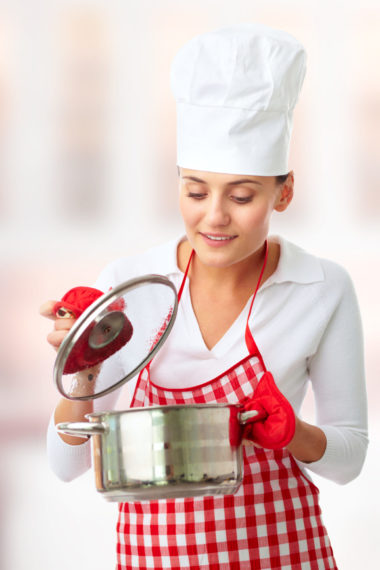
Have you ever wondered what cookware best suits your family’s needs? In today’s post, we are featuring the pros and cons of various types of cookware.
To help support our blogging activities, our site contains affiliate links. If you make a purchase from a link on our site, we may receive a small percentage of that sale, at no extra cost to you. Blessed Beyond Crazy is a participant in the Amazon Services LLC Associates Program, an affiliate advertising program designed to provide a means for sites to earn advertising fees by advertising and linking to amazon.com.
Disclaimer
First of all, before you begin reading this post let me first state that we are NOT being paid by any company or manufacturer to write this post and this is NOT a sponsored post. All opinions in this post are strictly our own. However, this post does contain affiliate links.
Recently I was on a personal mission to replace most of my kitchen pots and pans. Through some homework, personal experience, and trial-n-error I finally found what I was looking for.
I’ll let you know what I ended up buying at the end of this post, but in the meantime, Anna and I are going to discuss what is great, and not so great, about all the cookware options that are available.
#1. Cast Iron Cookware
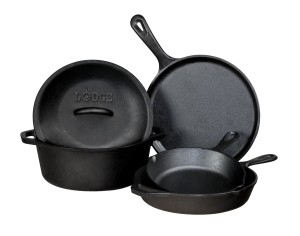
Pros:
- An old-fashioned way to cook fat-free
- Most porous of all metals
- No special utensils are needed to cook in it (i.e. you can use a metal spatula without fear of scratching it).
- Well-seasoned cast iron pan will only get better with age
- Conducts heat beautifully
- Great for searing and blackening
- Can go from stovetop to oven with no problem
- If properly cared for will last a lifetime
- Once you have a well-seasoned skillet you can cook with less amount of oil
- Chemical-free alternative to non-stick pans
- You can actually boost your iron intake because iron from the pan leaches into your food as it cooks
- Food cooks beautifully and it’s a great way to brown your food
- It can be used over any cooking source, therefore making it great for emergencies
- Inexpensive
Cons:
- It’s extremely heavy
- It can be a bit of a hassle to maintain and needs to be “seasoned” occasionally
- You can not use soap to clean it – unless you re-season it right away.
- It will rust if not properly maintained
- Grease can turn rancid in pores
- Needs to be stored with a bit of oily film on the inside to keep it from rusting and to keep it seasoned
(Anna)– This is my husband, and his family’s, favorite cookware hands down. His mother has given us several cast iron pans through the years and they last forever! I don’t have to worry about replacing these pans–ever!
(Linda) – I own several cast iron skillets. They are great for frying foods and I particularly love using a cast iron skillet to make fried chicken. I also love the durability of cast iron. Personally, I like using soapy water to clean my cookware but this tends to dull the “seasoning” of the cast iron. It is also very heavy.
Find Cast Iron Cookware
#2. Teflon Cookware
 Pros:
Pros:
- Easily washes with soapy water
- It’s non-stick
- Lightweight cookware
- Some brands of Teflon cookware can be placed in an oven at 350 degrees F for up to one hour
Cons:
- The surface can scratch, chip, and/or flake. As the pans get older the scratches get bigger and tend to chip easily, leaving chips of Teflon in your food.
- The pans may stain
- Needs to be “seasoned” before the first use and sometimes in between uses
- Pan warps under thermal shock (an overheated empty pan, a hot pan in contact with cold water or placed on a cold surface, etc.)
- The non-stick coating contains PFOA is a chemical that is used in the manufacturing of traditional PTFE-based nonstick cookware coatings and other products. PTFE is the abbreviated name for a remarkable polymer called polytetrafluoroethylene.
- The repellent coating that keeps food from sticking to nonstick pots and pans contains PFCs (perfluorocarbons), a chemical that’s linked to liver damage, cancer, developmental problems, and, according to one 2011 study in the Journal of Clinical Endocrinology & Metabolism, early menopause. PFCs get released—and inhaled—from nonstick pans in the form of fumes when pans are heated on high heat. Likewise, we can ingest them when the surface of the pan gets scratched.
- You get what you pay for. Meaning: Some brands may last for years and years while other brands will only last for a few months.
(Linda) – Through the years I have owned numerous Teflon pots and pans. The food rarely sticks to the pans and I enjoy cooking with it. After a time, though, the Teflon starts to come off. Time for new cookware!
Find Teflon Cookware
#3. Nonstick Ceramic Cookware 
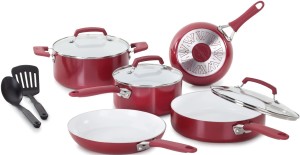
Pros:
- Easy to clean
- Comes in various pretty colors
- Food can be safely stored in it
- Dishwasher safe
Cons:
- Chips easily
- Not very durable
- Food sticks
- Safety is a question regarding ceramic cookware because it originates from the porcelain glaze. It often contains small amounts of lead.
(Anna)– I have only owned one ceramic pan. The first few times I used it I was amazed at how the food didn’t stick and LOVED using it. That only lasted for about a month before it started getting worn out and food began sticking. The pan only lasted for about 6 months before I had to replace it. Perhaps it was the brand I purchased, (it was an inexpensive pan), or that we used it quite often. I do believe that a pan should last longer than 6 months. I won’t be buying ceramic cookware again.
Find Nonstick Ceramic Cookware
Pros:
- Excellent heat conduction.
- Resists rust and corrosion
- Inexpensive
- Lightweight
Cons:
- Not desirable due to the Alzheimer’s and aluminum toxicity connection
- Very soft metal
- The extreme chemical reaction between food and pan – scratches easily and allows tiny food particles to collect and breed bacteria
- Can interfere with food and bring about certain undesirable chemical reaction and a metallic taste
- Can discolor food
- Not very durable
Find Aluminum Cookware
Pros:
- Made with a relatively new ceramic-based nonstick material that is said to be environmentally friendlier than traditional nonstick, which is petroleum-based.
Cons:
- Nonstick coating seems to become less effective over time.
- Should not be heated to high temperatures.
- Needs to be seasoned regularly.
- To avoid scratching the non-stick surface it is recommended that you do not use sharp or metal cooking utensils with the cookware.
(Linda) – I have owned two various skillet sizes of this cookware. At first, it worked like a dream and I loved it. After a year of use, the food started to stick more and more and I found myself “seasoning” the cookware often to help prevent this issue. I eventually discarded the skillets.
Find Orgreenic Cookware
#6. Starfrit The Rock Cookware

Pros:
- The speckled black finish creates a unique look.
- Lightweight
- Ultra-hard, rock-like surface offers incredible durability.
- Outstanding release performance that is 3 times better than traditional nonstick cookware.
- Thick, forged aluminum base lends even heat distribution
- Nonstick interiors ensure quick and easy clean up with soapy water
- Tempered glass lids lock in heat, moisture, and flavor.
- Stainless steel handles allow for a safe, secure grip.
- Oven safe up to 392 degrees F / 200 C
- Dishwasher safe (but may become dull due to the detergent)
Cons:
- To avoid piercing the non-stick surface you cannot use sharp or metal cooking utensils with the cookware.
- Add salt to water only after it comes to a boil. Salt grain deposits on the cookware bottom will attack the metal as the heat melts it down.
- Cannot use metal scouring pads to clean the surface.
- If using a ceramic stovetop, you should lift the pan rather than slide it across the glass plate or you could scratch your stovetop.
- Can only use on low to medium heat. Excessive surface temperatures can cause permanent damage to the non-stick surface.
- It is recommended that you add a teaspoon of cooking oil prior to each use for better non-stick performance.
(Linda) – I own a whole set of this cookware. It never sticks and is super easy to clean with soap and water. If you follow the directions and take care of it I believe this cookware will last a long time.
Find Starfrit The Rock Cookware
Pros:
- Glass-like enamel is usually covering some kind of metal, such as aluminum, steel or cast iron.
- Durable.
- Affordable.
- Lightweight.
- Conducts heat fast.
- Comes in a variety of colors.
- Naturally nonstick due to its non-porous surface.
- Good quality enamel cookware is oven safe up to 350 degrees F.
- Pans on the surface do not breed bacteria.
Cons:
- Enamel can chip, off then the metal underneath can rust.
- Food can scorch easily while cooking.
- Foods cool off quickly once removed from the heat source.
#8. Glass Cookware
Pros:
- Looks nice
- Can be used as a server
- Food can be watched while covered
Cons:
- Has hot spots and poor heat distribution.
- Foods stick and burn.
- Older glass cookware may contain lead.
- May chip, leaving sharp edges and shards of glass in food.
(Linda) – I have owned several pieces of glass cookware for years. I love that you can see the food cooking through the glass and can also serve the food right in the glass pans. Once the glassware is heated I find it necessary to stir the food often to keep it from scorching on the bottom of the pan.
Find Glass Cookware
#9 Stainless Steel Cookware 
Pros:
- Even cooking with few hot spots
- Heats up foods faster and uses less energy
- Doesn’t react with acidic foods
- Durable and long-lasting: expect 25 years of use
- Looks good and easy to see the food while it cooks (if you have a glass lid)
- Dishwasher safe
- The metal is an alloy, or combination, that includes small amounts of chromium and nickel, creating a surface that is resistant to rust and corrosion.
Cons:
- Buy the best surgical stainless steel cookware
- Many stainless steel pans are made with a lower grade of steel. Because of the softness of this grade of the metal, when heated, it expands and the food sticks to the pan. You are then forced to cook with oil and the pan becomes difficult to clean.
- Higher-priced stainless steel cookware has an added inner core made of copper or aluminum, which improves heat conductivity.
- For some people who have a nickel allergy, the small percentage of nickel may pose an issue.
- Unless you’re boiling water, the use of oil is also a must.
(Linda) – Nearly 30 years ago my parents bought me a whole set of stainless steel cookware. Overall, I really like this set of cookware. To this day, the pans themselves look almost brand new, (with the exception of the handles). The skillet is the one piece that food seems to stick in but the other pans do not stick. I still have several of the pieces but discarded the skillet and a smaller pan when the handle fell off of it.
#10. Copper Cookware
Pros:
- Excels at quick warm-ups and even heat distribution
- Professional look.
Cons:
- Because copper can leak into food in large amounts when heated, the cooking surfaces are usually lined with tin or stainless steel – over time, these coatings can break down and allow copper to dissolve in food.
- Reacts with alkaline or acidic foods, which can take on a metallic taste after being cooked in a copper pot.
- Certain foods (such as eggs), can develop gray streaks because they pick up copper compounds
- Older copper cookware may have tin or nickel coatings and should not be used for cooking
- Expensive
- There is upkeep (needs to be polished regularly and may need to be re-tinned every few years)
Find Copper Cookware
Conclusion:
You be the judge! We suggest that you personally look into all of the different available types of cookware on the market today and make your own decisions as to what style and construction you feel comfortable with. Be sure to look at quality first and remember that the most expensive item on the shelf isn’t necessarily the best quality on the shelf.
(Linda)– Out of all the different cookware available on the market today my personal favorite cookware is the new The ROCK Cookware by Starfrit. I purchased a complete set (#6 shown above) and love it. My food never comes close to sticking and the pans clean easily with soap and water. I can personally, (and highly), recommend this cookware and have purchased a whole set for my own personal use. In addition, I also purchased several of the skillets and gave them to family members as gifts. They love them too.
(Anna)– I too love The ROCK Cookware. I only have one skillet that I use on a daily basis and so far has held up its quality perfectly. I still love using cast iron and don’t expect to ever convince my husband to replace it with anything else (not that I want him to).
Our personal opinions are based on our own experiences. For your convenience, we have provided Amazon links. You can also find cookware on other websites and we recommend that you do a cost comparison to find the best price.
Happy Cooking!
Linda and Anna

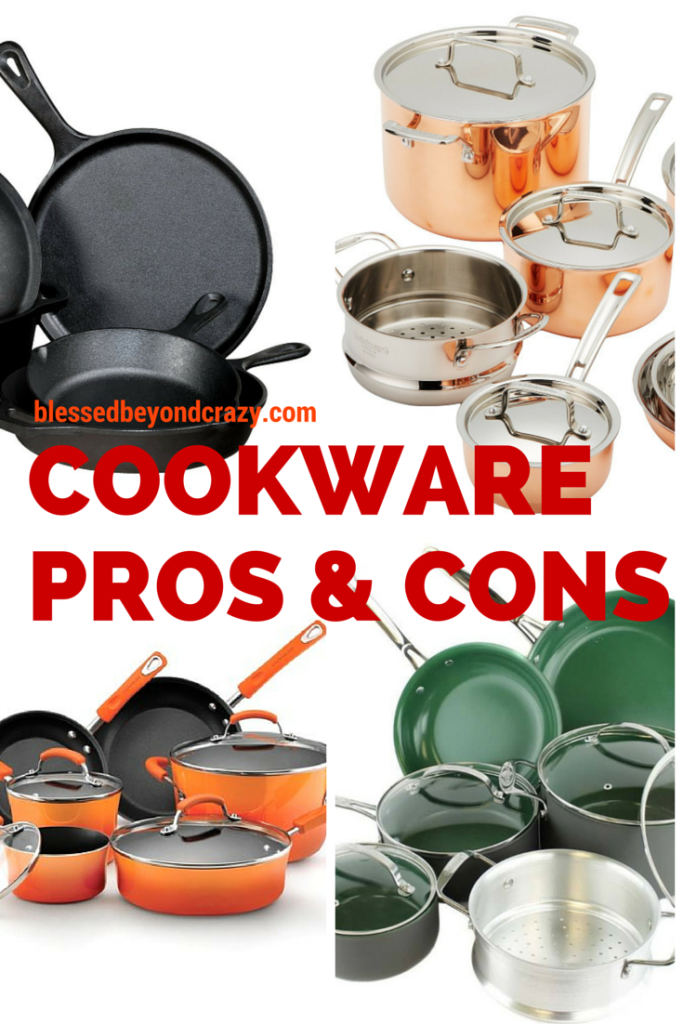
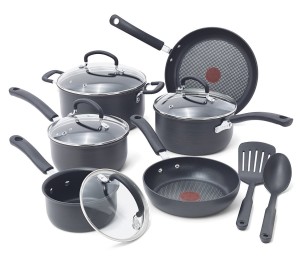
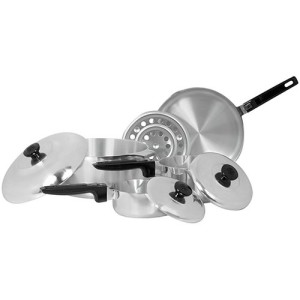
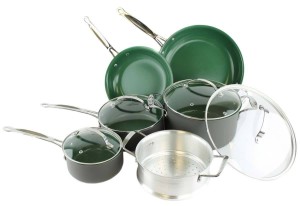
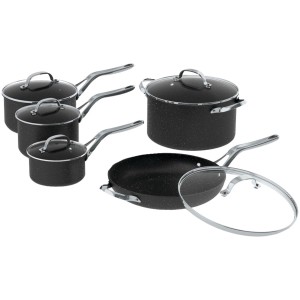
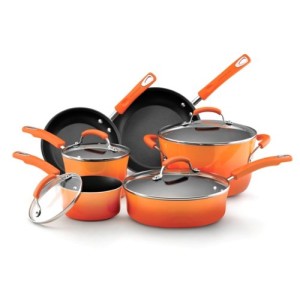
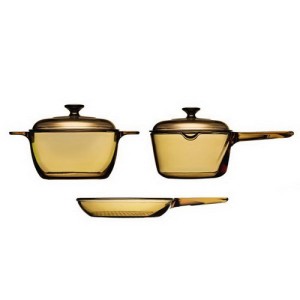
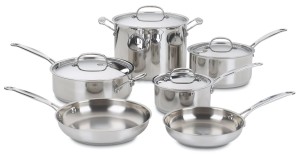
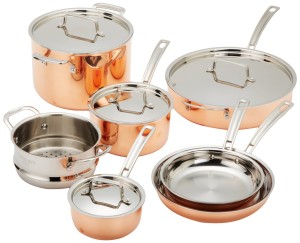
Phoenix Cooks says
Thank you for sharing. This information is very useful. I will share this information for many people.

Linda V. says
There is a way to make your stainless steel fry pans non-stick~~use veg oil and fry the green tops of green onions for about 5 mins on high~~I tried it and it works~~a tip from Christine Cushing (chef) on you-tube. I have also tried the fried salt method and it works too. I would be lost without my (expensive) stainless fry pan. So easy to clean, just add water and let sit till cool. Don’t go cheap.
Blessed Beyond Crazy says
Hey Linda,
Thanks for the tip! Linda & Anna
Carl says
I have always insisted on using a traditional iron pan, and if used properly, it is very good.

Nik says
We just use non stick cookware. Works just fine.

Łukasz Głuszcz says
You can check my opinions about granite rock pans if you want

Chin says
Hi, excellent review! Any idea on the pros and cons of stone cookware? Been eyeing a few in the market.
Blessed Beyond Crazy says
Hi Chin,
Thanks so much for stopping by and I’m happy that you enjoyed this particular blog post. Unfortunately, I have not done any research into stone cookware at this time. It is definitely something to look into though. If you should happen to buy some would you mind letting me know how you like it? Thanks! Linda
Monique Clarke says
Well Said. I got some very good information about kitchen cookware by reading this review. Now it’s easy to pick the best cookware for my kitchen. Thanks for the share.
Blessed Beyond Crazy says
Hi Monique,
Thank you!
Linda
Janice says
I appreciate your great reviews but I am still confused. Is the Rock by Starfrit the same thing as “Heritage The Rock”?
I am trying to decide between calphalon Hard anodized aluminum and Heritage The Rock. Do you know if they are both made of the same material?
Blessed Beyond Crazy says
Hi Janice,
Yes, I believe that they are one-in-the-same. I’m not sure, but I think they may have added the word “Heritage” to their name since Anna and I wrote this blog post. Sorry, but I do not know if calphalon Hard anodized aluminum and The Rock are made from the same material. I can tell you that after all these years I am still using and enjoying my Rock cookware. In my home, the skillets seem to get the most use and are showing a little wear so I may need to replace them someday, however, for now, they still work great. To help your cookware last longer, be sure to follow the manufactures directions (no matter whatever cookware you end up buying). Hope this helps! Linda
George says
A very important idea about cookware. I think it helps me to buy the best cookware for my kitchen.
Thanks for your amazing idea. Keep sharing!
Blessed Beyond Crazy says
Thank you! Linda
Inspired Kitchen says
I read out your article and found that its a very informative article. I got some good idea about cookware from this article its help me to buy a new cookware set in the future. Thank you.
Blessed Beyond Crazy says
You are most welcome! Thank you for stopping by and leaving us a nice message. Happy shopping! Linda
Linda says
I’m looking for nickel free frying pans. My doctor recommended iron stone.
As I don’t know what iron stone is and have spent hours on the internet trying to find iron stone pans I was wondering if you could help me.
Blessed Beyond Crazy says
Hi! I did a quick search for ironstone and here are a couple of links that explain what ironstone is and how to care for it. I hope this helps you. https://en.m.wikipedia.org/wiki/Ironstone_china and another article:
http://www.whiteironstonechina.com/careandcleaning.htm
Thanks for stopping by! Linda
Julie D. Crossett says
Thanks for sharing this kind of valuable info. I am looking for buy a good stove top and searching online for pros and cons. Just found your website.
You have done a good work, keep it up.

Blessed Beyond Crazy says
Hi Julie!
Hey, thanks so much for your kinds words! My daughter and I have a lot of fun working on our blog. Good luck with your shopping and thank you for stopping by and leaving us a message!
Linda
Handsome Paul says
Did you test Hexclad? I saw pans at Costco. They seem to be a hybrid of ceramic and stainless.
Blessed Beyond Crazy says
Nope! Never heard of them. Thanks for pointing them out.
Linda
airbnb cleaning sydney says
Thank you so much for this list and for the tips. Great article.
Blessed Beyond Crazy says
Thank you!
Maria says
I have a gas stove, would that have a negative impact on any of these sets? Thank you for your time and research.
Blessed Beyond Crazy says
Hi Maria,
I really am not sure if a gas stove would have a negative impact. I suggest that you check the manufacturing and product information to see what they suggest. Also, if you are interested in a particular set, you can always call the company and ask them.
Take care,
Linda
Danielle says
Hello 🙂 I am trying to find a healthy option for cooking our bacon and eggs in the morning. I have Lyme Disease and scary high levels of heavy metals in my system so don’t want any more! I use glass saucepans which work well but the once I cook my mushrooms in is all burnt and damaged. Might this be because the heat is too high? Just wondering if the same thing would happen with a frying pan if I bought one for our bacon and eggs. We like the bacon (nitrate free don’t panic) nice and crispy so wondering if that would work with glass frypan?? Any thoughts?? Danielle
Blessed Beyond Crazy says
Hi Danielle,
I also buy nitrate free bacon and I also understand your dilemma on how to get the bacon crispy. Instead of frying your bacon and eggs in a skillet I suggest lining a baking sheet with parchment paper or a silicone baking mat. Next, place your bacon on the baking sheet and baking it in a preheated 400-degree oven for 15 – 20 minutes. You can also cook eggs this way but may need to turn the temp down for them. Here’s a link that explains how > https://www.delish.com/cooking/a22502749/how-to-cook-bacon-in-the-oven-recipe/
Hope this helps. Linda
Edward Lye says
Hi, the locals have a term “jaga api” which translates to mind the fire/heat when cooking. Indeed you will find cooks adjusting the gas fire up and down while cooking, adding some ingredients now and others later. I don’t know what a glass frypan is but I have a ceramic one paired with an induction cooker. I fry my frozen bacon at the lowers setting of 300 Watts. Essentially the frypan is used as a hot plate. I prep the bacon before freezing by cutting into pieces and separating each layer with plastic from the frozen hamburgers packaging. I am a self taught “cook” so I tend to question conventional wisdom. 6 minutes then flip for another 6 minutes. This is sufficient for a burger and more than enough to cook bacon. It still looks pale and flat but cooked and aromatic. Good enough. I don’t like it shrivelled, dry and hard. If you extend the power/time it will brown. This makes bacon more of a filling than a garnishing.
Asma Sheikh says
Great post. I always love to use Ceramic and Stainless Steel cookware in my kitchen. They are safe for cooking any kind dishes and also easy to clean.

Blessed Beyond Crazy says
Thank you, Asma! Glad you enjoyed this post and thank you for visiting our blog!
Linda
Steve says
Re: Starfrit ..The Rock cookware
There appears to be 2 levels of quality priced at 2 levels of pricing.
Both by Starfrit by one called The Rock by Starfrit…the lower quality and
Heritage The Rock … much better product. I believe they are both made by Starfrit.
Which one did you test?
Blessed Beyond Crazy says
Hi Steve,
I believe it was The Rock by Starfrit. I’m not sure that the Heritage was on the market when we wrote that post.
Thanks for stopping by!
Linda
Wilmer says
Aluminium causes Alzheimer’s? Please link study from an acceptable source.
Wilmer says
You know that half the planet is covered in Aluminum right? A normal human being takes in about 10 milligrams of aluminium from water and other sources. Aluminium cookware gives off about 2 milligrams the most.
Asim Ramay says
https://www.ncbi.nlm.nih.gov/pubmed/21157018
https://www.ncbi.nlm.nih.gov/pmc/articles/PMC3056430/
there is a definitive link between AD and Aluminum, whether aluminium cookware leaks enough probably depends on the food cooked in it and the quality of the coating but when there are clear alternatives to for cookware, that are just as good why take the risk even if it eventually turns out that cooking in that type of cookware isn’t a health risk
Blessed Beyond Crazy says
Hi Asim,
I agree. Why chance it when there are better alternatives that pose less of a risk? Thank you for stopping by and leaving the links regarding the connection between AD and aluminum. It’s always good to hear other options.
Have a great day!
Linda
ilo says
Visit any nursing home and interview if they have used aluminum cookware and aluminum foil. They have. Ask if they have mercury fillings. They do.
Mira g. says
That was very helpful review for me . I was looking for answers for a while since I wasn’t sure wich material is leaking less metal and other harmful material in the food. Thank you. Very nice blog
I also like that you have links to go directly to Amazon and shop.
Blessed Beyond Crazy says
Hi Mira,
We are so glad that you found this particular post to be helpful. Thanks so much for stopping by and leaving us such a nice message. Have a wonderful day and “happy cookware shopping!” 🙂
Ric says
Hi, what about sterling silver and titanium?
Blessed Beyond Crazy says
Hi Ric,
Good question, however, as of the writing of this post, I have not done any research on sterling silver and titanium cookware. I’m sure there is information available on the web about these two types of cookware if you are interested in doing a little of your own research.
Thanks for stopping by! Good luck!
Linda
kathy says
Wow nice wok!! This is a very important article! After all the care we take to make sure what is going in our food is healthy and as nutritious as possible.
Blessed Beyond Crazy says
Thanks, Kathy! We appreciate you stopping by and leaving a message.
Have a great day!
Linda
Penny Robinson says
Thank you for this lesson in finding the right pots and pans to care for each other.
Love,
Penny
Margaret W. Word says
Informative post. I prefer to use ceramic cookware that is PTFE and PFOA free.
Glenda says
I was pleased with The Rock pans and thought I had found the answer for non stick cookware until recently when I discovered small black flakes attaching to scambled eggs as I flipped it over. After cleaning with the plastic scrubber and trying again…same thing…had to through the eggs. Creeped me out as I do not know what black coating is made of..or how much we have already ingested unnoticed. I have had the pans for over 2 years and now noticing more “silver” shows through which means the black coating is coming off in the food.
Blessed Beyond Crazy says
Hi Glenda,
Oh my, I’m so sorry to hear this. You may want to contact the makers of this cookware and see if they will replace it for you. One of my lids cracked so I contacted them and sent them a picture of the cracked lid. They replaced the lid and gave me a voucher for another free product. I found their customer care to be most accommodating and helpful. If you do contact them, you may want to mention my blog post to them. Just an idea because I sure mentioned it. Please let me know how things turn out and thanks for letting me know about this problem.
Take care,
Linda
amelie says
thank you for helpful information & your cookware photoes are really charming .
Blessed Beyond Crazy says
Thank you, Amelie!
Linda
Lita Watson says
I see that some types of copper cookware can easily be scratched, although it’s very expensive.
Vivian says
Thank you for the tips. Very helpful!

Mr. B. says
I like this review, but i don’t like at the end they recommend some brand-name, with the link to amazon so readers can buy it right away. It makes me suspicious of their motive. I think they are making directly from ROCK Cookware by Starfrit. This is very crappy, because it first this article seemed unbiased. I wish they had kept it that way all the way through. Greedy people! not good.
Blessed Beyond Crazy says
Hi Mr. B.
It’s interesting to me that you feel that this post is suspicious. You are certainly free to your opinion, however, please allow me to refresh your memory. At the very beginning of this post, I state that I was on a mission to replace my personal cookware. Throughout the post, I provided Amazon links for every type of cookware that is mentioned, not just the ROCK Cookware by Starfrit. These links are provided for our reader’s convenience and as stated on the HOME page of our blog, “To help support our blogging activities, our site contains affiliate links. If you make a purchase from a link on our site, we may receive a small percentage of that sale, at no extra cost to you. Blessed Beyond Crazy is a participant in the Amazon Services LLC Associates Program, an affiliate advertising program designed to provide a means for sites to earn advertising fees by advertising and linking to amazon.com.” Every blogger I know and almost every blog post I’ve ever read contains some type of affiliate links to help support their blog.
You can believe what you want, but we did not / have not received any kind of payment or kickback from Starfrit. In my opinion, it was just the best cookware option for me. Period.
At the end of the post, I provide numerous links to other information on various cookware. Also, at the very end of the post I state, “*All views are based on our own opinions and personal experiences. For your convenience, we have provided Amazon links if you are interested in any of the cookware mentioned. You can also find cookware on other websites and we recommend that you do a cost comparison to find the best price.”
It really surprises me that you feel we were being greedy in this post. I simply feel that we provided our readers with information and our personal opinions while encouraging our readers to do their own research and cost comparisons.
But, as I said, you have a right to your opinion and we have a right to ours.
Have a good day!
Linda
emuge lazaro says
really see this is good
Blessed Beyond Crazy says
Hi Emuge,
Thank you!
Linda